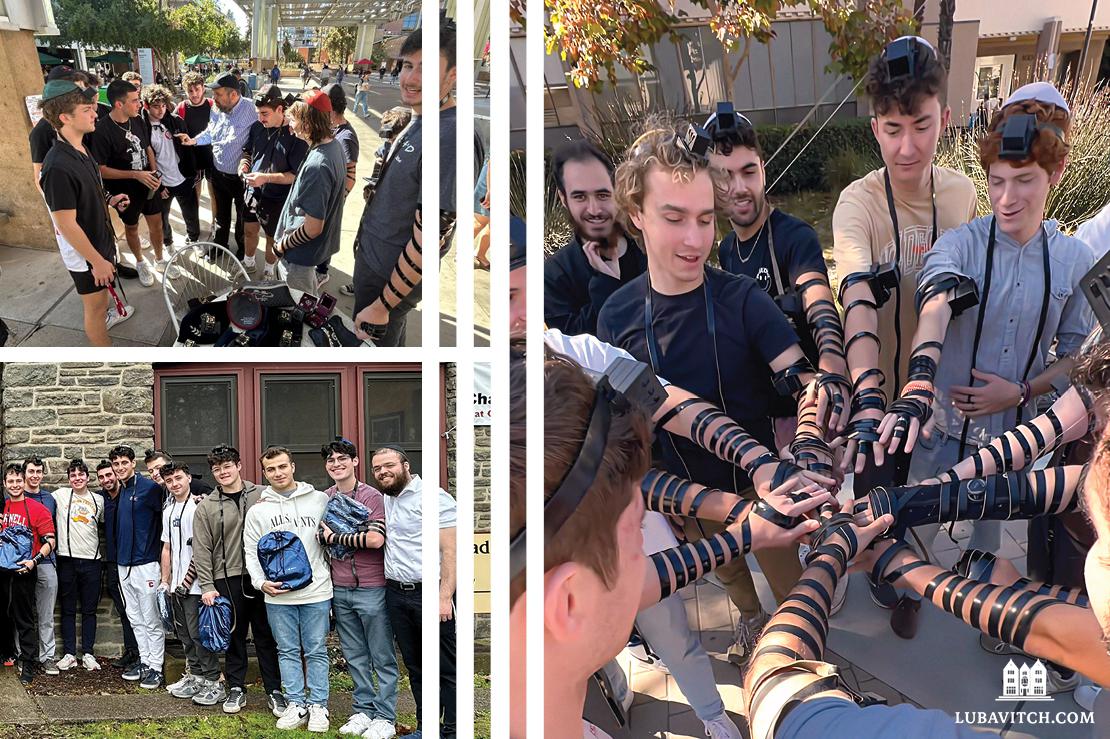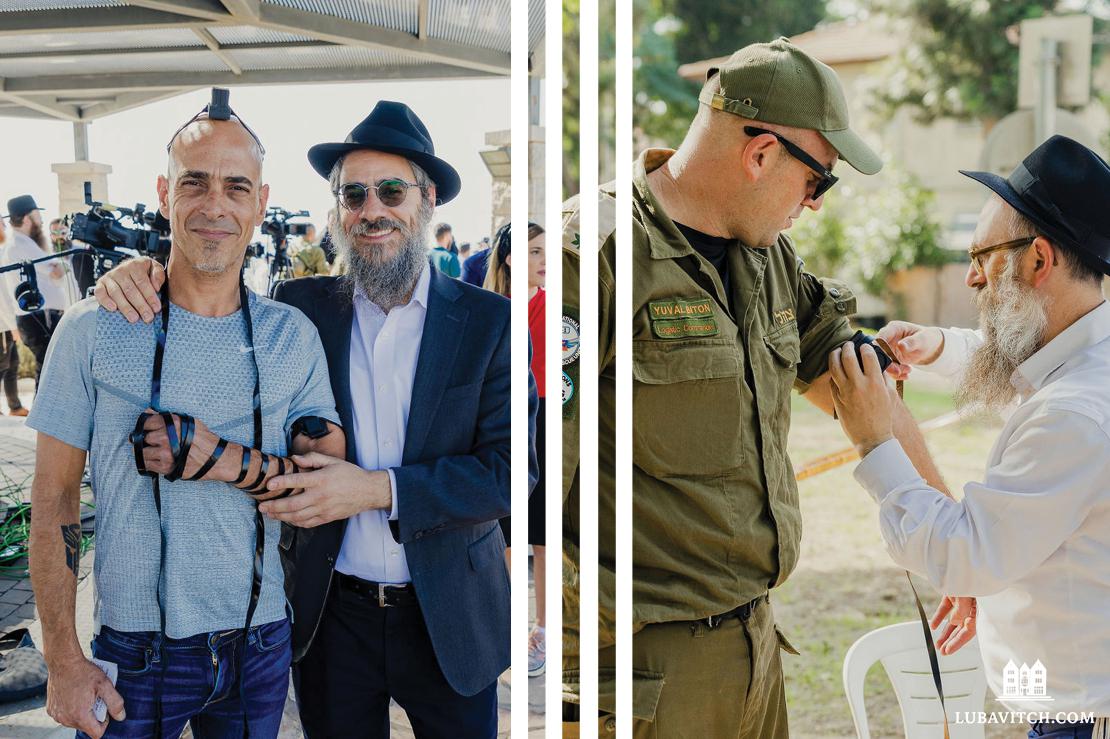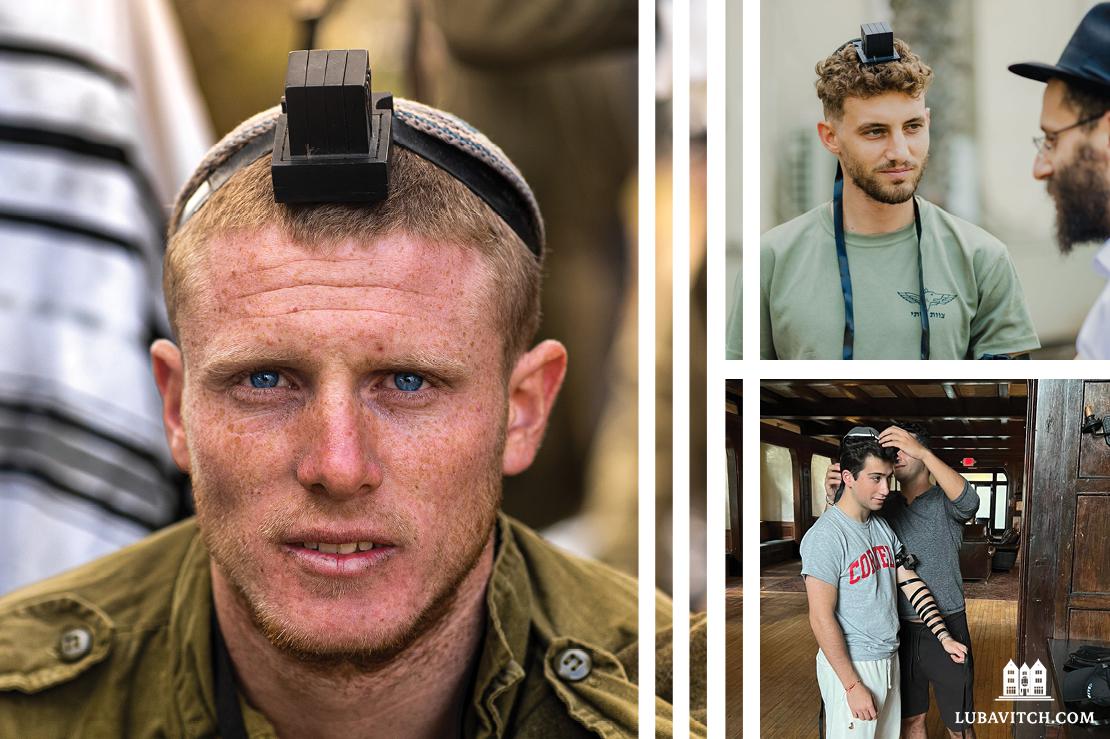On American college campuses, on street corners in Israel, and on Instagram, one ritual has emerged as a symbol of Jewish identity and shared experience.
I have this chain,” says David Vilensky, pulling a star of David pendant from under his T-shirt. “When people are attacking Jews, part of me wants to put this away, hide it, and pretend like I’m not Jewish.”
In the days after Hamas murdered 1,200 Israeli citizens and took some 240 hostage, Vilensky, a senior at Cornell University, thought a lot about his necklace. The Ithaca campus was convulsed by protests; vile threats against Jews appeared in an online forum; swastikas materialized on dormitory walls.
As the middle ground slid away, students like Vilensky, who attends synagogue once or twice a year, felt a pressure to declare themselves and choose a side.
It has been a difficult year, he says, but there was something that helped him get through it: A few weeks before the Hamas attack on October 7, a friend had invited him to join a “tefillin challenge,” in which participants donned the black boxes containing sacred parchments daily for forty days. Something about the ritual spoke to Vilensky immediately.
“I’m always worrying about the future,” he says. “When I wrap tefillin, even if it’s just for a few minutes a day, I feel very present. The wrapping itself is calming.”

Vilensky wore his star of David proudly throughout the semester, but that was for other people to see. The tefillin was for him. “It’s coming from more of an inner place,” he says. “It’s more about your identity, looking inward rather than looking out.”
Out of the Synagogue
A literal black box of a mitzvah, tefillin has always contained an element of mystery. Deuteronomy’s ambiguous command to bind G-d’s words “as a sign upon your hand, and they shall be for you an ornament between your eyes” is interpreted quite simply: Inside the boxes are parchments inscribed with four biblical passages that form the fundamentals of Jewish faith—the unity of G-d, the Exodus from Egypt, the obligation to transmit the words to one’s children. And yet the mystery lingers, inspiring diverse and sometimes conflicting rabbinic interpretations of the mitzvah’s meaning. Throughout much of Jewish history, however, tefillin has been personal, a private ritual performed in synagogue or at home, the boxes bound on the arm, opposite the heart, and on the head, a symbol of the wearer’s whole-hearted and suprarational dedication to G-d.
But in 1967, tefillin moved out of the synagogue and onto the battlefield. In the terrifying days leading up to the Six Day War, the Rebbe, quoting the Talmud, promised that soldiers who performed the mitzvah would strike fear into Israel’s enemies. Among the first initiatives after Israel’s stunning victory was the establishment of a tefillin stand at the newly liberated Western Wall, and in the six decades that followed, tefillin became a commonplace on city streets all over the world, where Chabad Chasidim offer it as a quick way to do something Jewish.
Visually arresting, physically personal, tefillin is a potent symbol in an age of social media signaling.
Now, in the wake of the October 7 attacks, tefillin has again become a locus of cultural and spiritual meaning. On American college campuses, on street corners in Israel, and pervasively on social media, Jews are turning to tefillin—and, in an unprecedented way, promoting it to others—as an expression of their spiritual identity and a means of connecting to their people.
New Jewish Influencers
On October 18, sophomore Aleeza Feffer was accosted on Palm Walk, Arizona State University’s main campus corridor: “Five guys came up in my face and started yelling at me, just for wearing a T-shirt that says, ‘I love being Jewish,’” she recalls.
Two weeks later, Feffer gathered with roughly twenty other ASU students in the same place to recite the Shema prayer publicly. In the video, posted to Instagram, a student wearing tefillin declares: “Through thousands of years of persecution, we’re still standing. That’s why we’re doing this here.” At the end of the video, the students nominated three other universities to make a similar public statement of Jewish pride.

Visually arresting, physically personal, tefillin is a potent symbol in an age of social media signaling. In the immediate aftermath of the Hamas attack, videos circulated of celebrities like the actor Josh Peck donning tefillin; a clip of a student at the University of Pennsylvania putting on tefillin while pro-Palestinian protestors marched behind him garnered hundreds of thousands of views.
At Cornell University, seniors Adam Abergel and Matias Lancewicki were juggling several different Whatsapp groups devoted solely to tefillin. For their senior capstone project at the Dyson Business School, the two had pitched a tefillin challenge: participants would commit to don tefillin daily for forty days, evaluating their mental health and feelings of spiritual connection at the beginning and end of the challenge. (A 2018 study by researchers at the University of Cincinnati found that wearing tefillin daily may increase cardiovascular health.) Successful contestants would be rewarded with a designer sling bag, manufactured by Lancewicki’s fledgling luggage company, EZRI.
The project launched in September, but it took off after October 7. “People wanted to do something for Israel, do an act, because they felt helpless from afar,” Abergel says. Within a few months, the EZRI Challenge had spread to thirty-seven campuses with approximately five hundred students participating.
The tefillin challenges at Cornell and ASU received support from the Chabad reps on their respective campuses, but both projects were student-initiated and led. Charismatic and gregarious, Abergel grew up in a French Moroccan family in Los Angeles. The tefillin challenge, he says, was a way to convey his passion for Judaism to his fellow students: “I really wanted to redefine what Judaism was for them. I wanted to show them that Judaism is not a burden. It’s fun.”

Feffer, who describes herself as naturally shy, was so disturbed by her experiences at ASU and the administration’s lackadaisical response that, in December, she testified before the Arizona State Legislature. Just as important to her, however, were positive projects like the Tefillin Together challenge, which she plans to help expand to include other mitzvahs that can be performed publicly. “When October 7 happened, I felt that I need to be open, and spread that it’s good to be Jewish,” she says.
A week after the ASU students posted their video, Jewish students at the schools they had nominated posted their own videos, and nominated nine other campuses. “It kind of just took off,” Feffer says. The project’s Instagram page currently has forty videos from colleges and universities around the country, and counting.
Touch Point and Target
Israel is the birthplace of the tefillin campaign and has remained its vital center. Tefillin stands are ubiquitous there, woven into the country’s life in a way that bears comparison to American chain stores, or Starbucks. Over the past year, however, proposed judicial reforms had polarized Israeli society, reducing a nuanced palette of religious and political affiliations to a stark left vs. right, hilonim (secular) vs. hareidim (religious) divide. Tefillin stands—run by Chasidim and catering to secular Jews—are one of the few places where the two sides meet, a touch point, and, in the tense political atmosphere, occasionally a target.
Tefillin stands—run by Chasidim and catering to secular Jews—are one of the few places where the two groups meet, a touch point, and, in Israel’s tense political atmosphere, occasionally a target.
Last June, a woman approached a tefillin stand in Tel Aviv’s Habima Square and confronted the Chabad rabbinical student who was running it with an onslaught of criticism. The woman’s video of the encounter went viral on social media, though it did not generate the reaction she had perhaps hoped for.
Public opinion was decisively on the side of tefillin, says Rabbi Eli Naiditch, who runs Chabad of the Coast, an English-speaking community in Tel Aviv: “In the past few years there’s been a massive awakening, a renaissance where people are coming closer to spirituality and their Judaism.” The video received extensive media coverage, and Chabad representatives reported a surge in demand for tefillin all over the country. With a few exceptions, then, Israelis saw the tefillin stands as something apart from, perhaps above, the political paroxysm that was roiling the country.
The events of October 7 and the ensuing war in Gaza have united the country squarely behind a shared Jewish identity, of which tefillin has become the most visible symbol. The story of twelve-year-old Ariel Zohar, who requested that his grandfather’s tefillin be rescued from the ravaged home in Kibbutz Nahal Oz where his parents and older sisters were murdered, encapsulated both Israelis’ grief and their steadfast pride in their identity. In the IDF, tefillin has become a sought-after commodity, says Rabbi Naiditch, who serves in a search-and-rescue unit. “There’s a huge demand for tactical tefillin cases, bullet-proof tubes with a water-proof lining,” he says. The demand for tefillin on army bases, he notes, has outpaced supply: “There’s a backlog. They don’t have enough tefillin to sell.”

On January 9 this year, a Chabad rabbinical student manning a tefillin stand outside of Tel Aviv’s famously secular Herzliya Hebrew Gymnasium high school was approached by the school’s principal and roughly told to move. A video of the encounter was posted online, and when the Chabad student returned the next day, hundreds of young people converged on the stand, waiting in line for their turn to put on tefillin.
Unspoken Assumption
Behind the Israeli students’ embrace of tefillin, and the initiatives on American college campuses, is an unspoken assumption that has been part of the tefillin campaign from its inception: Judaism isn’t all or nothing. Jewish tradition is a resource for all Jews, no matter their level of observance.
A few days into the tefillin challenge at Cornell, David Vilensky came to Abergel and Lancewicki with an unusual request: instead of receiving a sling bag at the end of the forty-day challenge, he wanted to keep the pair of tefillin they had loaned him and continue using it.
Behind the Israeli students’ embrace of tefillin, and the initiatives on American college campuses, is an unspoken assumption that has been part of the tefillin campaign from its inception: Judaism isn’t all or nothing.
This spring, Vilensky, together with several other students, will continue the EZRI Tefillin Challenge as his own senior capstone project in the Dyson School. The group plans to expand the challenge to include mitzvahs like Shabbat candle lighting, and to leverage social media to spread the challenge internationally. For Vilensky, tefillin has become a bit of an obsession. “I carry it around with me wherever I go,” he says. “I wrap tefillin with my grandpa whenever I see him, and with my friends.”
But the meaning of the challenge is not limited to a particular mitzvah or observance, Vilensky says: “There’s no requirement for how Jewish you have to be. You can be Orthodox; you could be completely secular. Just help spread Judaism. Show that it’s always going to be there and be proud of it.”
This article appears in the Spring/Summer 2024 issue of Lubavitch International, to subscribe to the magazine, click here.

Be the first to write a comment.